Evaporative Cooling Market Size
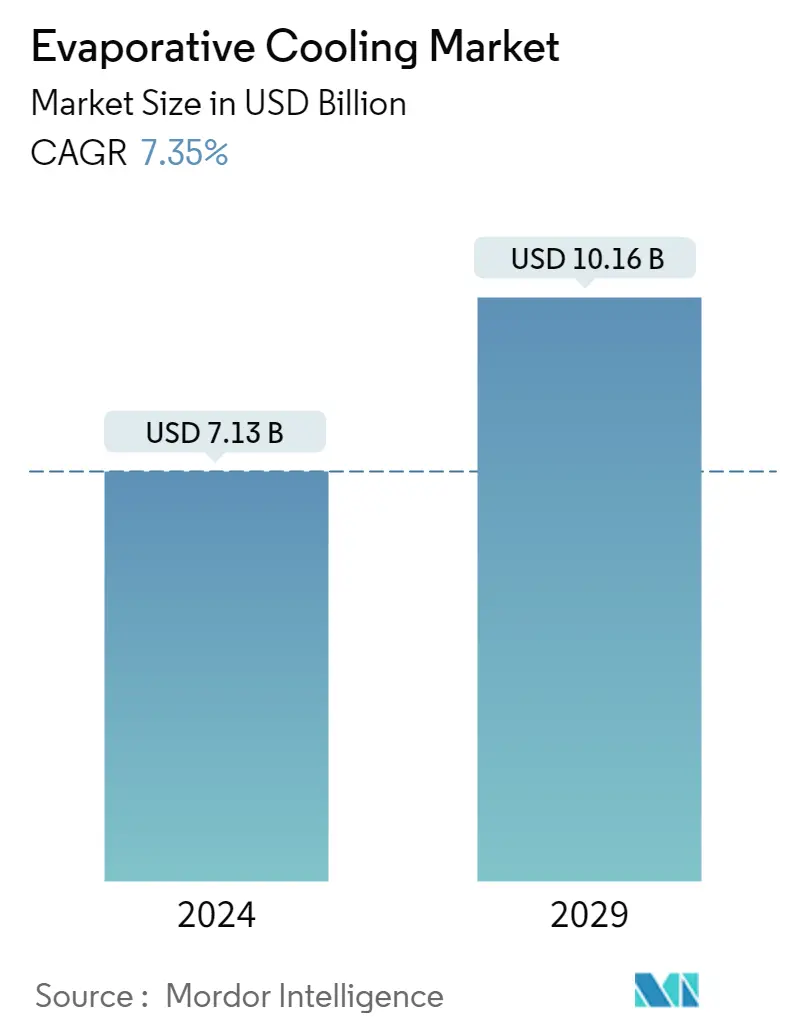
| Study Period | 2019 - 2029 |
| Market Size (2024) | USD 7.13 Billion |
| Market Size (2029) | USD 10.16 Billion |
| CAGR (2024 - 2029) | 7.35 % |
| Fastest Growing Market | Middle East and Africa |
| Largest Market | Asia Pacific |
Major Players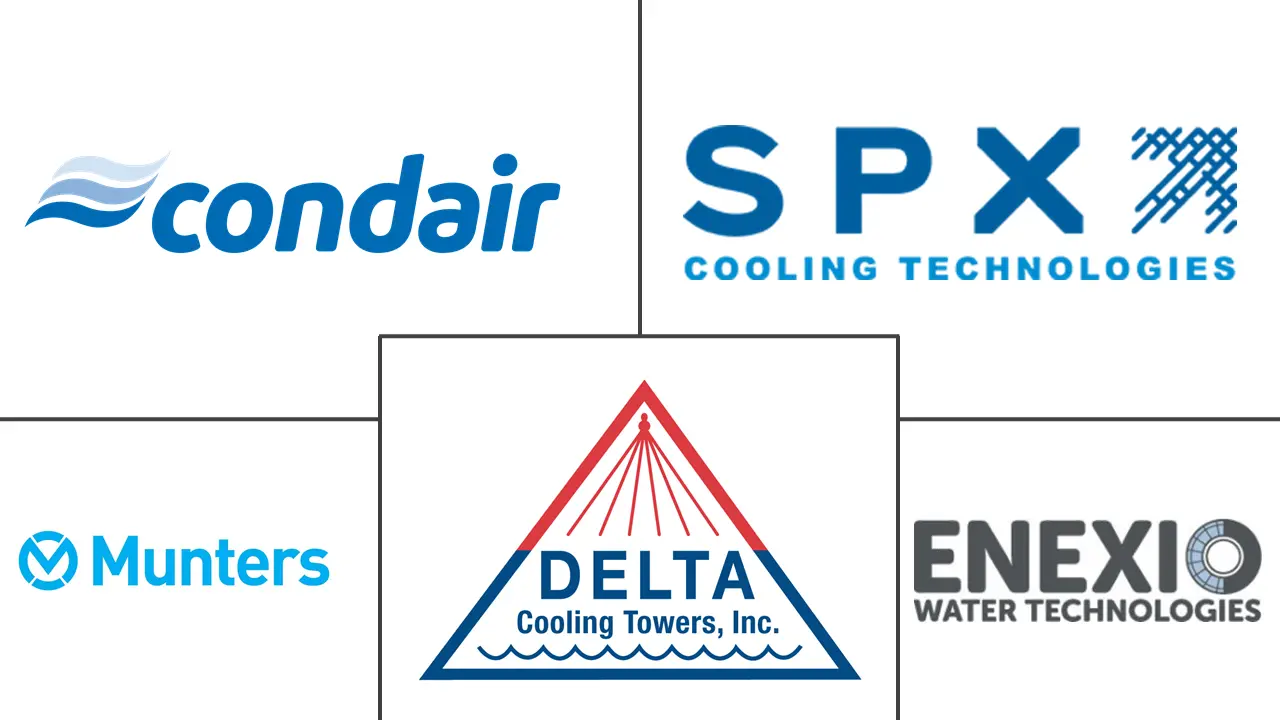
*Disclaimer: Major Players sorted in no particular order |
Need a report that reflects how COVID-19 has impacted this market and its growth?
Evaporative Cooling Market Analysis
The Evaporative Cooling Market size is estimated at USD 7.13 billion in 2024, and is expected to reach USD 10.16 billion by 2029, growing at a CAGR of 7.35% during the forecast period (2024-2029).
- As heat waves happen more frequently owing to climate change, millions of people are in danger of exposure to temperatures that could be fatal. People worldwide have been impacted by rising temperatures, making it imperative to address the need for cooling without having a negative carbon footprint, which has been a significant element driving the industry.
- Because evaporative coolers employ fewer parts than air conditioning systems, such as a fan, pump, and water, to chill the room, they can cool various spaces for a meager cost and with minimal operational costs. These evaporative cooling systems' low ownership costs are one of their main benefits.
- Additionally, various governments worldwide have been offering saving programs to promote energy-efficient technologies. For example, as evaporative cooling has been a proven sustainable cooling technology, these systems have been made eligible for the Energy Investment Deduction (EIA) in the Netherlands, which could result in more than 11% net benefit on the entire investment.
- Furthermore, because these systems use fewer components and are, therefore, more energy efficient, evaporative cooling has been one of the most affordable cooling options on the market. For instance, Canstar Blue estimates that the typical reverse cycle split system air conditioner may run at about USD 0.60 per hour. However, with an additional USD 0.02 for water, an evaporative cooling system may cost less than USD 0.10 per hour.
- These evaporative cooling systems' high reliance on the surrounding air quality has been one of their main disadvantages. Since the evaporative cooling process is driven by the temperature difference between the ambient air's dry and wet bulb temperatures, this difference is negligible for moderate and highly humid regions, which results in a constrained cooling capacity.
- On the other hand, the Indian Society of Heating, Refrigerating and Air Conditioning Engineers (ISHRAE), among other regulating authorities globally, has urged more fresh air intake and ventilation in the current pandemic scenario. Due to this, end users are now compelled to consider integrating evaporative cooling systems, which might significantly improve indoor air quality and offer secure workspaces with less energy use.
Evaporative Cooling Market Trends
Direct Evaporative Cooling to Hold a Major Share
- By utilizing the latent heat of evaporation, which transforms liquid water into water vapor, direct evaporative cooling reduces the temperature and raises air humidity. It is the most basic, traditional, and widely utilized form of evaporative cooling. These evaporative coolants are anticipated to have a limited niche market in the United States, mainly in the south, where the relative humidity at noon in July is above 40%.
- The direct evaporative cooling systems are also appropriate for applications that require significant heat-load replacement and are willing to use outside air to do it. Their applications are widely used in buildings, warehouses, commercial kitchens, and residential settings with laxer comfort standards. The system requirements, therefore, depend on the end users and the established operational performance criteria. Most buildings' evaporative coolers are natural systems, while some indirect ones are also employed.
- The industrial sector accounts for the largest market share among all end-user applications, driven by the large-scale deployment of direct evaporative coolers. The industrial applications for direct evaporative coolers include Buildings, warehouses, factories, manufacturing units, power generation, oil and gas, construction, and many more.
- Additionally, the industrial sectors implement advanced evaporative cooling systems to foresee the need for maintenance before a problem arises. The most recent cooling technologies, which employ Internet of Things (IoT) techniques, contain sensors, connections, software, and other components that let the system communicate with other connected devices. IoT solutions enhance preventative maintenance by collecting information on equipment status and air quality.
- As a result, many businesses concentrate on direct evaporative cooling (DEC), frequently the most energy-efficient method of cooling a data center. To grow its data center cooling sector, which includes natural evaporative cooling, Munters, for instance, shifted its Virginia staff to the new facility in April 2021. A 365,000-square-foot facility for manufacturing, R&D, and sales was the company's USD 36 million investment target.
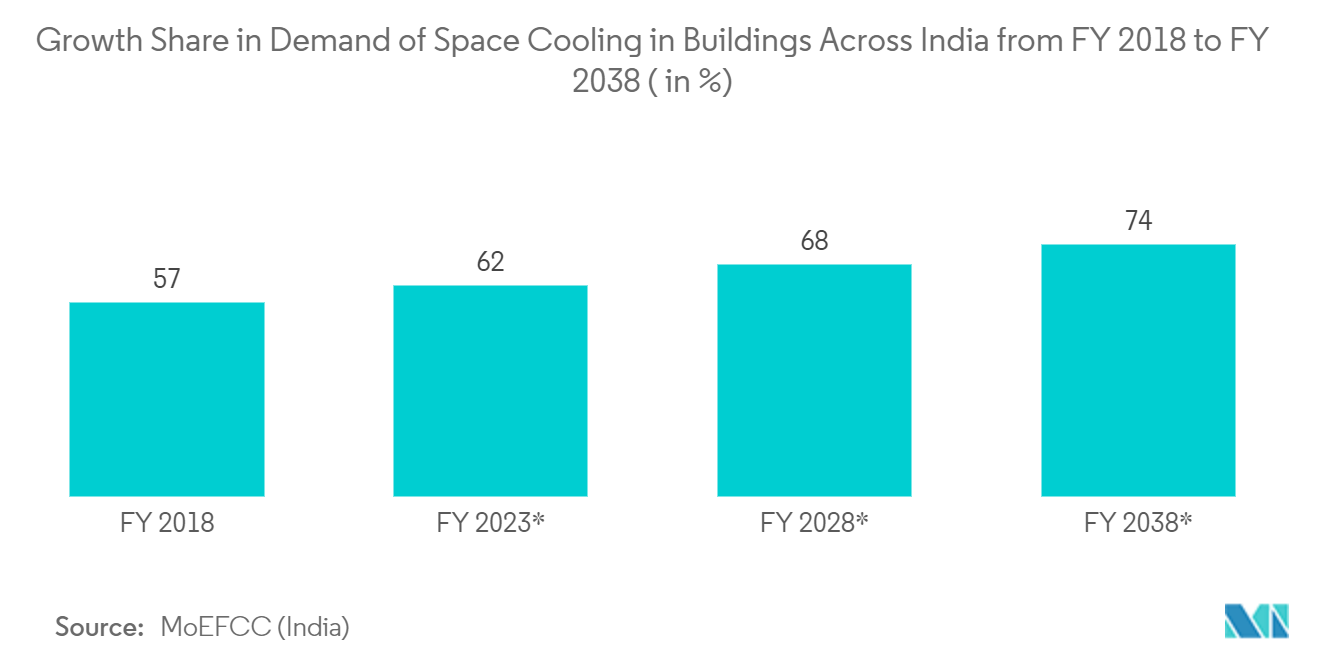
The Asia-Pacific Region to Hold Significant Market Share
- The Southeast Asian region is anticipated to experience a significant demand for AC sales, driven by rising temperatures and rising earnings, expected to reach 300 million units by 2040; it is anticipated that Indonesia will supply half of the world's air conditioning units.
- In addition, research from the International Energy Agency states that cooling equipment sales are dominated by China, the United States, and Japan, with India and Indonesia experiencing the most significant rise. Although China sold over 500 million units in the past ten years, India and Indonesia had a relative increase in demand for air conditioning that was more rapid, with average yearly installations expanding at a pace of over 15% in both countries. (India)
- South Asia is experiencing exponential growth in the demand for air conditioning, driving the need for economic and simple cooling techniques. When considering these nations' targets for reducing carbon emissions, evaporative cooling is one of the finest solutions. Southeast Asia boasts among the Asia-Pacific region's fastest-growing data center marketplaces, although the sustainability of these facilities is still a problem for the area.
- Nevertheless, it is anticipated that in the upcoming years, sustainability will become a key differentiator in Asia between data center providers, particularly as leading tech companies around the world, like Microsoft, Google, and Apple, set standards with carbon neutral and zero sustainability goals and as cutting-edge energy-efficient technology is developed.
- Since data center cooling accounts for between 35% and 40% of overall energy demand, it represents a significant hurdle to sustainability in Asia. Most data centers in the area currently employ air-based cooling, a very ineffective and expensive solution.
- Companies in the area are switching more and more to evaporative cooling techniques. For instance, data centers can be sustainable thanks to cooling technology like evaporative cooling. As data centers become more prominent to accommodate the demands of digitalization, these technologies enable businesses to employ indirect evaporative, direct evaporative, hybrid systems, and liquid cooling to reduce Power Usage Effectiveness (PUE) and overall energy usage.
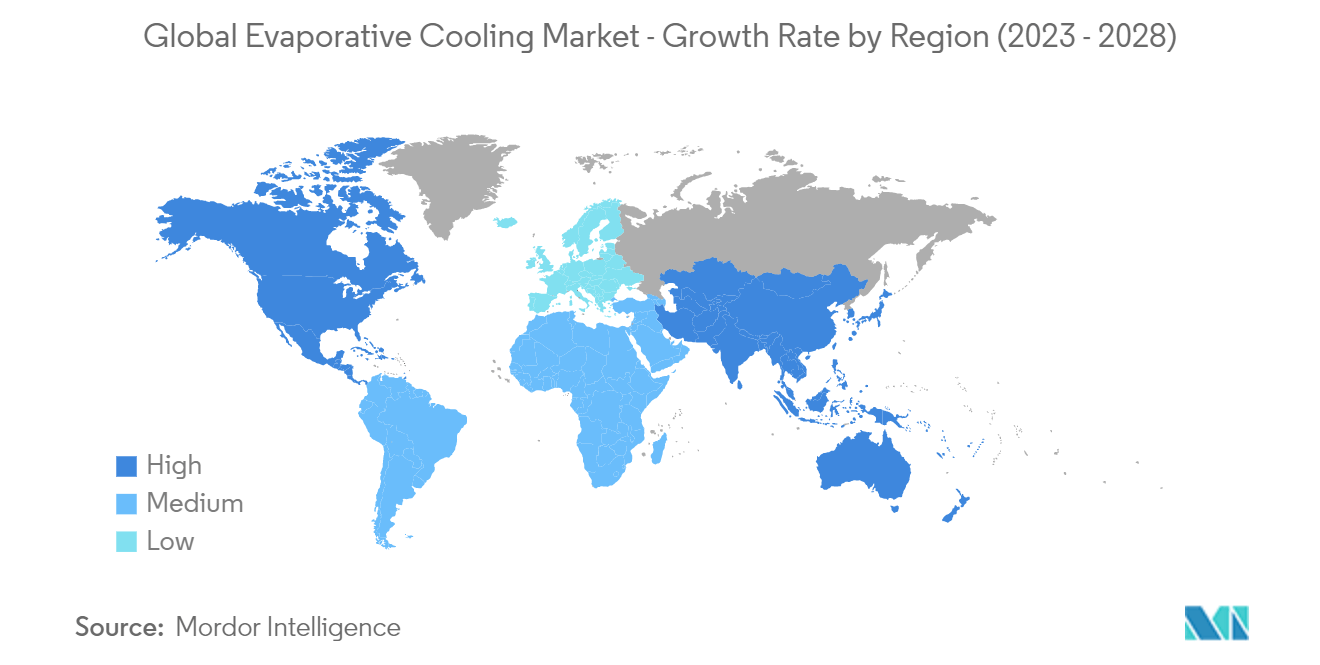
Evaporative Cooling Industry Overview
The Evaporative Cooling Market is moderately competitive and consists of several major players. In terms of market share, few of the major players currently dominate the market. With a prominent share in the market, these major players are focusing on expanding their customer base across foreign countries. The major players include companies like Delta Cooling Towers Inc., Condair Group AG, SPX Cooling Technologies, etc. The competition and rapid technological advancements are expected to pose a threat to the growth of the companies during the forecast period.
In May 2023, Xiaomi Youpin launched the MIJIA Smart Evaporative Cooling Fan, which provides its customers with a refreshing and comfortable indoor environment. The smart fan launched by the company has been designed to provide three effects in one - blowing, cooling, and humidifying. It would be equipped with a circulating water cooling system, which allows the addition of water and ice crystals to bring different cooling effects. The innovative wireless water tank patent design allows the tank to be removed from the body for cleaning at any time, ensuring hygiene and convenience.
Evaporative Cooling Market Leaders
Delta Cooling Towers Inc.
Condair Group AG
Munters Group AB
SPX Cooling Technologies
ENEXIO Water Technologies GmbH
*Disclaimer: Major Players sorted in no particular order
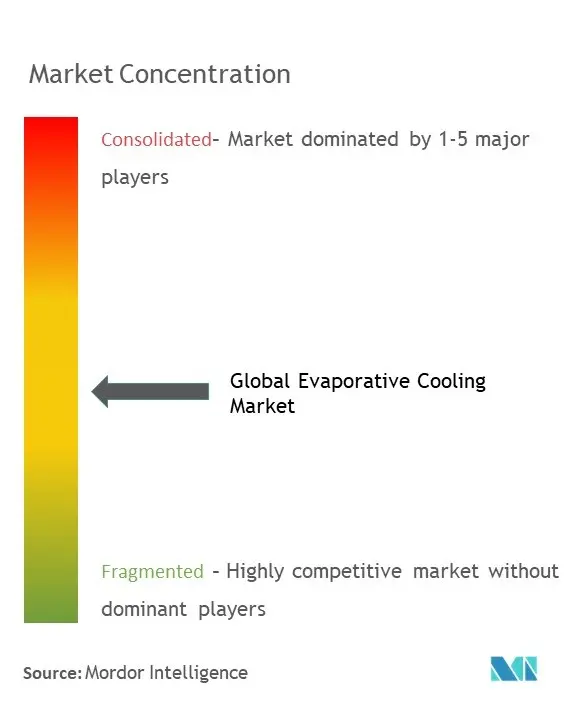
Evaporative Cooling Market News
- Aug 2022: The United States Department of Agriculture's (USDA) Natural Resources Conservation Service (NRCS) approved a new conservation practice, a Water Conservation System commonly known as an Evaporative Cooling Pad. The pad will help reduce water and energy use while improving plant productivity in Florida nursery operations and existing greenhouses. Moreover, it can also be used for cooling livestock and poultry facilities.
Evaporative Cooling Market Report - Table of Contents
1. INTRODUCTION
1.1 Study Assumptions and Market Definition
1.2 Scope of the Study
2. RESEARCH METHODOLOGY
3. EXECUTIVE SUMMARY
4. MARKET INSIGHTS
4.1 Market Overview
4.2 Industry Value Chain Analysis
4.3 Industry Attractiveness - Porter's Five Forces Analysis
4.3.1 Bargaining Power of Suppliers
4.3.2 Bargaining Power of Consumers
4.3.3 Threat of New Entrants
4.3.4 Intensity of Competitive Rivalry
4.3.5 Threat of Substitutes Products
4.4 An Assessment of the Impact of COVID-19 on the industry
4.5 Analysis of the Evaporative Cooling Hotspot
4.6 Comparative Analysis of Alternative/Substitute Cooling Technologies Deployed in the Residential and Commercial Sectors
5. MARKET DYNAMICS
5.1 Market Drivers
5.1.1 Demand for Cost-effective Cooling Solution
5.2 Market Restraints
5.2.1 Dependency on External Climate
6. MARKET SEGMENTATION
6.1 By Type of Cooling
6.1.1 Direct Evaporative Cooling
6.1.2 Indirect Evaporative Cooling
6.1.3 Two-stage Evaporative Cooling
6.2 By Application
6.2.1 Residential Applications
6.2.2 Commercial Applications
6.2.3 Industrial Applications
6.2.4 Confinement Farming
6.2.5 Other Applications
6.3 By Distribution Channel
6.3.1 Big-box Retailers
6.3.2 HVAC Contractors and Distributors
6.3.3 Other Distribution Channels
6.4 By Geography
6.4.1 North America
6.4.2 Europe
6.4.3 Asia-Pacific
6.4.4 Rest of the World
7. COMPETITIVE LANDSCAPE
7.1 Company Profiles
7.1.1 Delta Cooling Towers Inc.
7.1.2 Condair Group AG
7.1.3 SPX Cooling Technologies
7.1.4 Baltimore Aircoil Company Inc.
7.1.5 Munters Group AB
7.1.6 Colt Group Limited
7.1.7 Phoenix Manufacturing Inc.
7.1.8 Bonaire
7.1.9 ENEXIO Water Technologies GmbH
7.1.10 CFW Evapcool
7.1.11 Celsius Design Limited
- *List Not Exhaustive
8. INVESTMENT ANALYSIS
9. FUTURE TRENDS
Evaporative Cooling Industry Segmentation
Evaporative cooling is preferred as an alternative to traditional cooling technologies, as it uses a natural process, namely the reduction of air temperature by evaporating water. Although it is an age-old process, it has emerged as a viable alternative to conventional air conditioning systems in areas where shallow temperatures are not required.
The Evaporative Cooling Market is segmented by Type of Cooling (Direct Evaporative Cooling, Indirect Evaporative Cooling, and Two-stage Evaporative Cooling), Application (Residential Applications, Commercial Applications, Industrial Applications, and Confinement Farming), Distribution Channel (Big Box Retailers, HVAC Contractors, and Distributors), and Geography.
| By Type of Cooling | |
| Direct Evaporative Cooling | |
| Indirect Evaporative Cooling | |
| Two-stage Evaporative Cooling |
| By Application | |
| Residential Applications | |
| Commercial Applications | |
| Industrial Applications | |
| Confinement Farming | |
| Other Applications |
| By Distribution Channel | |
| Big-box Retailers | |
| HVAC Contractors and Distributors | |
| Other Distribution Channels |
| By Geography | |
| North America | |
| Europe | |
| Asia-Pacific | |
| Rest of the World |
Evaporative Cooling Market Research FAQs
How big is the Global Evaporative Cooling Market?
The Global Evaporative Cooling Market size is expected to reach USD 7.13 billion in 2024 and grow at a CAGR of 7.35% to reach USD 10.16 billion by 2029.
What is the current Global Evaporative Cooling Market size?
In 2024, the Global Evaporative Cooling Market size is expected to reach USD 7.13 billion.
Who are the key players in Global Evaporative Cooling Market?
Delta Cooling Towers Inc., Condair Group AG, Munters Group AB, SPX Cooling Technologies and ENEXIO Water Technologies GmbH are the major companies operating in the Global Evaporative Cooling Market.
Which is the fastest growing region in Global Evaporative Cooling Market?
Middle East and Africa is estimated to grow at the highest CAGR over the forecast period (2024-2029).
Which region has the biggest share in Global Evaporative Cooling Market?
In 2024, the Asia Pacific accounts for the largest market share in Global Evaporative Cooling Market.
What years does this Global Evaporative Cooling Market cover, and what was the market size in 2023?
In 2023, the Global Evaporative Cooling Market size was estimated at USD 6.64 billion. The report covers the Global Evaporative Cooling Market historical market size for years: 2019, 2020, 2021, 2022 and 2023. The report also forecasts the Global Evaporative Cooling Market size for years: 2024, 2025, 2026, 2027, 2028 and 2029.
Evaporative Cooling Industry Report
Statistics for the 2024 Evaporative Cooling market share, size and revenue growth rate, created by Mordor Intelligence™ Industry Reports. Evaporative Cooling analysis includes a market forecast outlook to for 2024 to 2029 and historical overview. Get a sample of this industry analysis as a free report PDF download.
